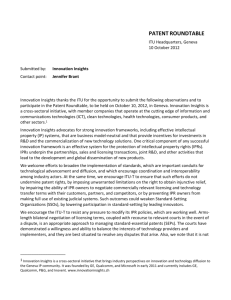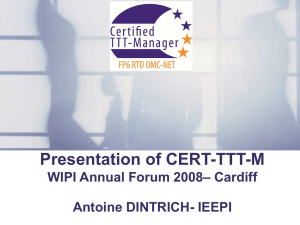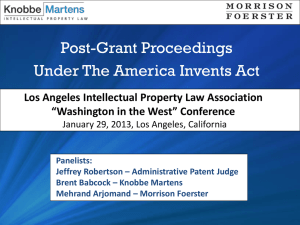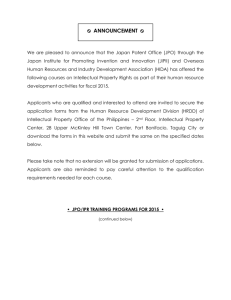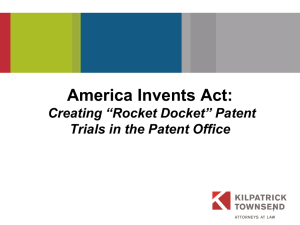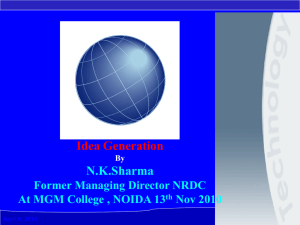Innovation Centre at University of Latvia: structure and costs
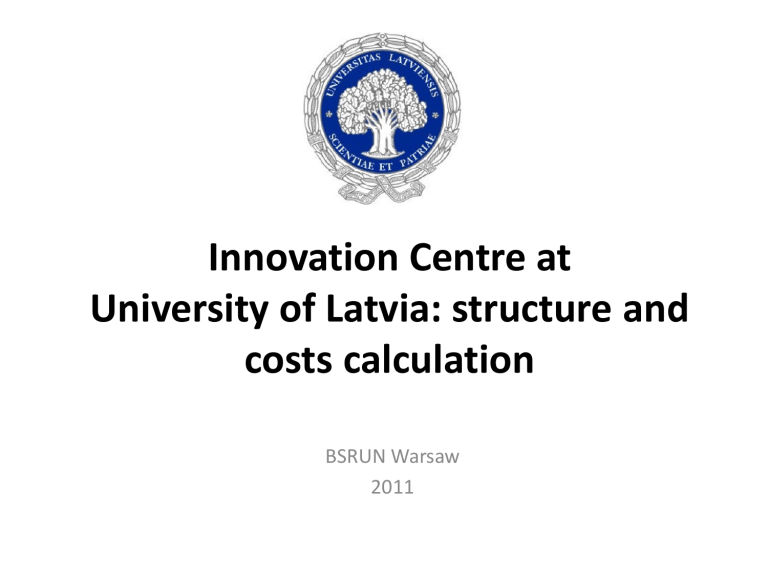
Innovation Centre at
University of Latvia: structure and costs calculation
BSRUN Warsaw
2011
Facts about University of Latvia
Faculties – 13
Institutes – 21
Study programmes – 140
• Undergraduate 56 (40%)
• Graduate – 60 (43%)
• Doctoral – 24 (17%)
Students – 19 095
• Undergraduate 14 339 (75%)
• Graduate – 3 903 (20%)
• Doctoral – 853 (5%)
Staff – 2954
• Academic staff – 797 (45%)
• Administration – 207 (6%)
• Other staff – 1 950 (49%)
Budget – 71 173 775 EUR (int.al. 17 772 015 EUR balance at beginning of year)
Income structure of the UL budget, million EUR, 2006-2010
70
60
50
3
10
3
12
3
8
4
10
40
30
20
10
3
7
34
47
51
42
45
0
2006 2007 2008 2009 2010
Other revenue (including rent)
Research projects
Study income- revenue from tuition fees, state funding for higher education, EU structural funds and other projects
10
8
6
14
12
4
2
0
Research income structure of the UL budget, million EUR, 2006-2010
1,25
5,59
1,05
8,88
0,88
10,74
0,50
7,04
0,42
9,28
2006 2007 2008 2009
Revenue from commercial research activities
Revenue from non-commercial research activities
2010
32%
Research income structure of the UL budget, million EUR, 2010
0%
4%
EU structural funds 5 006 355 €
12%
State funding for research activities 3 101
338 €
International funding 1 157 469 €
52%
Commercial contracts works 421 346 €
Other revenue 17 679 €
21%
Research expenditure structure of the
UL budget, million EUR, 2010
5%
5%
1%
Wages, social insurance allocations 6 554 254 €
Services 1 983 996 €
Travel and subsistence 509 388 €
68%
Materials and supplies 501 384 €
Fixed assets and intangible assets
119 820 €
University of Latvia applied and approved patents 2006.-2010.
8
6
4
2
0
16
14
12
10
2
2006
2
14
11
8
4 4 4
2007 patent applications
2008 2009 approved patents
4
7
2010
Patent cost calculation
I. DIRECT COSTS
1. Wages, social insurance allocations
2. Travel and accommodation costs
3. Materials and supplies
4. Services (including patent application costs)
II. DIRECTLY ALLOCATED COSTS
1. Equipment costs (depreciation)
2. Facilities / building depreciation costs and premises-related running costs (electricity, rent, supply, water supply and sewerage, heating, waste disposal, taxes, service staff remuneration):
III. INDIRECT COSTS
1. Faculties and institutes administration and support costs (wages, social insurance allocations, supplies, services, equipment, facilities, etc.)
2. University central administration and support costs (wages, social insurance allocations, supplies, services, equipment, facilities, etc.)
IV. PROFIT
1.
Patent cost calculation example
I. DIRECT COSTS 44 783.41
Wages 37 008.41
1.1.
Wages
1.2.
2.
1.1.1. Head researcher
1.1.2. Researcher
1.1.3. Laboratory assistant
State social insurance contributions
2. Travel
2.1. Brazil
3.
Materials, including:
4.
3.1. Lab materials
3.2. Computers
Services and other expenses, including:
4.1. Telecommunication services
4.2. Technical Maintenance
4.3 Intellectual poperty protection
Proportion
One hour of rate Ls / h Productive productive hours hours x 3 230 x
10
8
4
1 050
1 380
800
82%
82%
90%
Working hours 29 823.85
3 852
1 280 12 804.88
1 683 13 463.41
889 3 555.56
7 184.57
Unit cost, Ls
1000
Amount
2
2 000.00
2 000.00
Unit cost, Ls Amount 600.00
20
500
5
1
100.00
500.00
Unit cost, Ls
15
50
5000
Amount
5
2
1
5 175.00
75.00
100.00
5 000.00
Patent cost calculation example
(continued)
II. DIRECTLY ALLOCATED COSTS
5.
6.
Equipment costs (depreciation) UL inventory number
Costs Ls per 1 hour
Working hours
0.25
1750 5.1. Measuring instrument 111224
5.2.
Facilities / building depreciation costs and the premises related running costs
(electricity, rent, supply, water supply and sewerage, heating, taxes, service staff wages):
Room costs for 1FTE hour, Ls
6.1. Kronvalda St. 4, room 312 0.29
6.2.
Working hours
3 852
1 554.67
437.50
437.50
0.00
1 117.17
1 117.17
Patent cost calculation example
(continued)
III. INDIRECT COSTS
7.
Faculties and institutes administration and support costs (wages, social insurance allocations, supplies, services, equipment, facilities, etc.)
8.
Cost driver-1 Ls
University central administration and support personnel costs (wages, social insurance allocations, supplies, services, equipment, facilities, etc.)
Cost driver-1 Ls
% of overheads
5%
% of overheads
6%
TOTAL (I.+II.+III.)
Profit 5%
Contract Price
VAT 22%
The contract price including VAT 22%
Direct costs
44 783
Direct costs
44 783
4 926.18
2 239.17
2 239.17
2 687.00
2 687.00
51 264.26
2 563.21
53 827.47
11 842.04
65 669.51
UL Innovation Centre / general information
•
Innovation centre of Technology transfer office
•
Since 2006th
–
As part of MoE financed project to make TTO network in Latvia
•
Structural unit in Planning and Development department
•
4 employees competent in: innovation management; biology, chemistry, physics; microbiology, pharmacy; IPR management
•
The average age of employees 34 years
UL Innovation Centre / functions
− Management of internal environment (IPR
management, innovation support services to researchers, internal communication, education to researchers etc.)
− Marketing (to companies)
− Supporting the development of innovative ideas
− Initiating commercialization processes
UL Innovation Centre / the main results
• Date base of Competences - information about
82 groups of researchers
– Marketing tool for selling contract research projects)
– we have visited every group of researchers
• 124 potentially commercialable ideas, technologies
• 25 seminars and contact/brokerage events
– 3 spin offs have been established
• 23 commercialization proposals
UL Innovation Centre / IPR
− Registered IPR
− 1 international patent
− 3 European patent applications
− 11 Latvian patent applications
− IPR management regulations: elaborated and introduced
− IPR belong to University of Latvia
− researchers have to inform IC about the potential IPR
− IC evaluates the commercial potential before granting support to protect IPR
− Revenue sharing model - 50:50
UL Innovation Centre revenue / expenses structure
Revenue
ERDF
ESF UL budget
Co-financing
IC administration
Intellectual poperty protection
Conferences and travel
Expenses
UL Innovation Centre revenue / expenses structure 2006.-2010. EUR
Revenues
UL budget
Ministry of Economics
ESF projects
ERDF projects
Expenses
IC administration
Conferences and travel
Intellectual poperty protection
2006 2007 2008 2009 2010
76 764 120 944 93 948 99 610 110 843
69 003
-
7 761
55 492
48 336
17 116
12 806
-
-
14 229
-
-
-
-
-
81 142 85 381 110 843
76 266 107 484 103 187 91 320 110 771
57 769
9 960
8 537
78 713
9 533
19 237
83 409
7 826
11 952
71 699
8 964
10 657
92 167
5 976
12 628
Challanges
•
Weak cooperation between industry and researchers;
•
Commercial vs ‘academic’ value of patent;
•
Project results (IP) belongs to financer;
•
ERDF for non-commercial research projects;
•
In time IPR expenses increase and value decrease;
